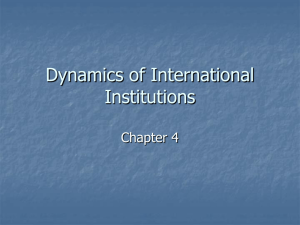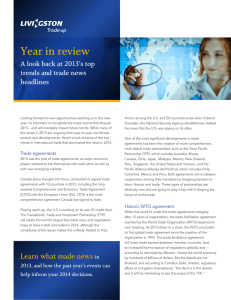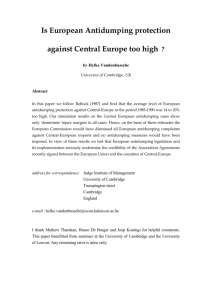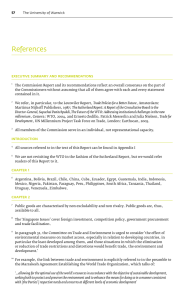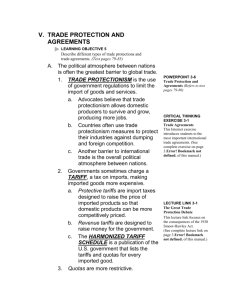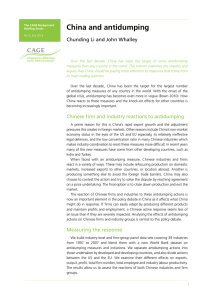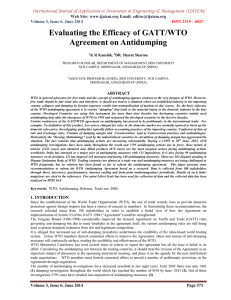Trade Policy in a Globalised World CAGE/CEP Workshop on
advertisement
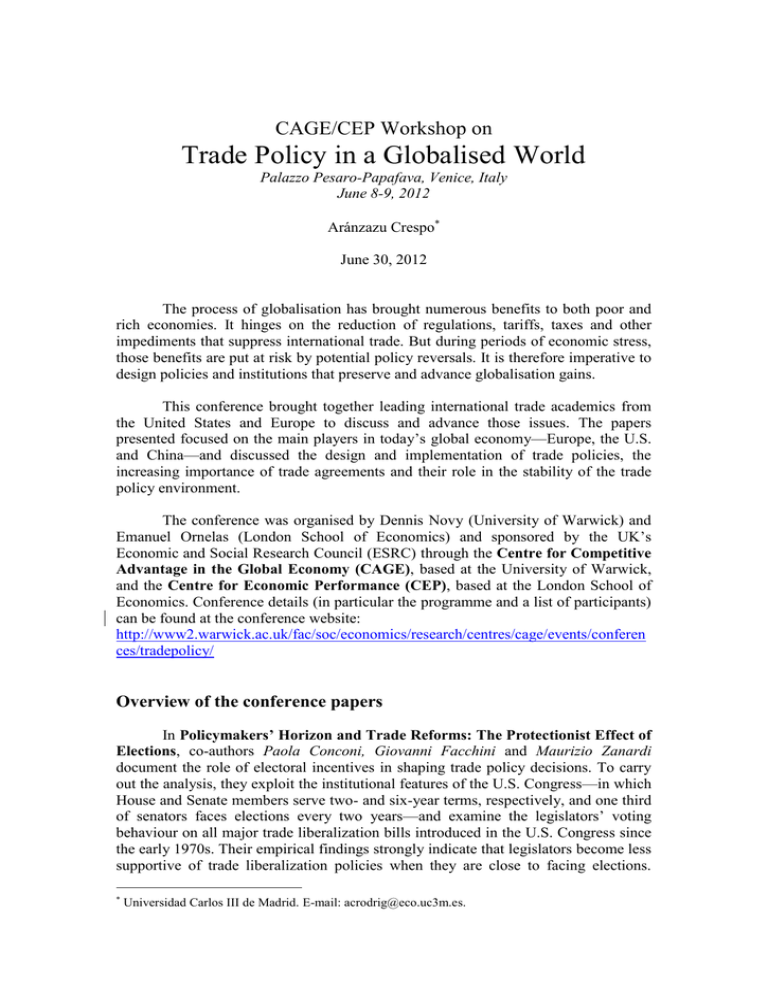
CAGE/CEP Workshop on Trade Policy in a Globalised World Palazzo Pesaro-Papafava, Venice, Italy June 8-9, 2012 Aránzazu Crespo June 30, 2012 The process of globalisation has brought numerous benefits to both poor and rich economies. It hinges on the reduction of regulations, tariffs, taxes and other impediments that suppress international trade. But during periods of economic stress, those benefits are put at risk by potential policy reversals. It is therefore imperative to design policies and institutions that preserve and advance globalisation gains. This conference brought together leading international trade academics from the United States and Europe to discuss and advance those issues. The papers presented focused on the main players in today’s global economy—Europe, the U.S. and China—and discussed the design and implementation of trade policies, the increasing importance of trade agreements and their role in the stability of the trade policy environment. The conference was organised by Dennis Novy (University of Warwick) and Emanuel Ornelas (London School of Economics) and sponsored by the UK’s Economic and Social Research Council (ESRC) through the Centre for Competitive Advantage in the Global Economy (CAGE), based at the University of Warwick, and the Centre for Economic Performance (CEP), based at the London School of Economics. Conference details (in particular the programme and a list of participants) can be found at the conference website: http://www2.warwick.ac.uk/fac/soc/economics/research/centres/cage/events/conferen ces/tradepolicy/ Overview of the conference papers In Policymakers’ Horizon and Trade Reforms: The Protectionist Effect of Elections, co-authors Paola Conconi, Giovanni Facchini and Maurizio Zanardi document the role of electoral incentives in shaping trade policy decisions. To carry out the analysis, they exploit the institutional features of the U.S. Congress—in which House and Senate members serve two- and six-year terms, respectively, and one third of senators faces elections every two years—and examine the legislators’ voting behaviour on all major trade liberalization bills introduced in the U.S. Congress since the early 1970s. Their empirical findings strongly indicate that legislators become less supportive of trade liberalization policies when they are close to facing elections. Universidad Carlos III de Madrid. E-mail: acrodrig@eco.uc3m.es. Surprisingly, this is true even for the politicians who represent export-oriented regions. In U.S. presidential politics, a swing state is a state in which no single party has overwhelming support in securing that state’s electoral votes, so that a small change in policy may shift the election in one direction or another. In A Swing-State Theorem, with Evidence, John McLaren and Xiangjun Ma model and empirically show evidence of protectionist policies in the U.S. towards industries located in swing states. Overall, industries located in swing states appear to have an easier time securing trade protection than industries located in states with a clear partisan bias. The logic of protection in this case has nothing to do with appealing to a median voter or with responding to lobbyists. Voters care both about policies and the identity of the party in power, and party preferences are correlated within each state. Therefore, most states will be biased towards one party or the other. As a result, electoral competition induces politicians to cater to the interests of the citizens of the few swing states, with little regard to the citizens from the rest of the country. Import protection and other trade policies typically generate externalities in other countries, affecting their consumers and producers. Thus, some degree of international cooperation would be expected. Indeed, international trade agreements have become increasingly important. At the multilateral level, for example, the World Trade Organization (WTO) system already encompasses around 98% of global trade among its members. A key design feature of the WTO and of its predecessor, the General Agreement on Tariffs and Trade (GATT), is that governments negotiate bound tariff levels rather than exact tariffs. Manuel Amador and Kyle Bagwell, authors of On the Optimality of Tariff Caps, develop a new application of delegation theory to the theory of trade agreements to interpret this precise feature. Governments negotiate trade agreements to maximize the welfare of all the countries involved, where a trade agreement is defined by a set of allowed import tariffs and associated wasteful bureaucratic procedures. After signing a trade agreement, the importing government observes the level of political pressure from its importcompeting industry and then selects its preferred tariff from the set of permissible tariffs. The framework provides an interpretation of a common but little understood practice where a WTO member government applies a tariff below its negotiated bound level. Despite the scope for cooperation, it is almost inevitable that formal attempts at cooperation will also lead to occasional disagreement, and in fact international trade disputes have erupted with increasing frequency in recent decades within the GATT/WTO system. In Trade Disputes and Settlement, Giovanni Maggi and Robert Staiger highlight the role of transaction costs, contract renegotiation and settlement between the governments in a breach of international trade agreements. They propose a model that delivers predictions about the outcomes of trade disputes, including outcomes in which governments settle early, renegotiate court rulings, or implement the rulings. The model also yields interesting predictions regarding the nature of settlements. On the one hand, any post-ruling settlement must be liberalizing. On the other hand, early settlement can go in either direction—freer trade or greater import protection. These predictions are examined in light of data on the outcomes of actual trade disputes in the GATT/WTO system. Parallel to the multilateral system, preferential trade agreements (PTAs) have also become widespread. There are over 300 PTAs currently in force and the trend is not showing any sign of abating. Naturally, tariff reductions are a key aspect of any PTA. However, they are usually just one part of the overall agreement. In Protection Reduction and Diversion: PTAs and the Incidence of Antidumping Disputes, Thomas Prusa and Robert Teh provide new empirical evidence that PTAs alter the pattern of protection by focusing on antidumping activity. They estimate that antidumping provisions in PTAs have decreased the incidence of intra-PTA antidumping cases by 33-55%, but have increased the number of antidumping actions against non-PTA members by 10-30%. The results suggest that while PTA members are spared from antidumping actions (“protection reduction”), non-PTA members face even greater antidumping scrutiny (“protection diversion”). Now, both the WTO and many preferential trade agreements explicitly state that they seek to increase the predictability of the trade policy environment. Nuno Limão and Giovanni Maggi examine the link between trade agreements and trade policy uncertainty in Uncertainty and Trade Agreements. The origin of the uncertainty (common or country-specific) and the type (shocks to economic fundamentals or to political preferences) is important in determining the direction and strength of the policy-uncertainty reducing motive for a trade agreement. Their study suggests that under the conditions that generate an uncertainty-reducing motive, the agreement leads to higher investment in the export sector, promoting further international trade. Dennis Novy and Alan M. Taylor study the relationship between uncertainty and international trade from a different perspective. In Trade and Uncertainty, they investigate the response of international trade to economic shocks. In response to a large uncertainty shock to the demand for final products, firms optimally adjust their inventory policy by cutting their orders of foreign intermediates disproportionately strongly. In the aggregate, this response leads to a bigger contraction in international trade flows than in domestic economic activity. Empirical analysis using highfrequency monthly U.S. import and industrial production data going back to 1962 confirms that real imports react much more to uncertainty shocks than industrial production, suggesting a tight link between uncertainty and the cyclical behaviour of international trade flows. The home bias in trade puzzle is another widely-discussed feature of the global economy. It was first documented by John T. McCallum in “National Borders Matter: Canada-U.S. Regional Trade Patterns” (1995). McCallum showed that for the United States and Canada, inter-province trade is 20 times larger than international trade, holding other determinants of trade fixed. In Geography and Intra-National Home Bias: U.S. Domestic Trade in 1949 and 2007, Nick Crafts and Alexander Klein show that the home bias in the U.S. was considerably smaller in 1949 than in 2007, and argue that the difference between the geographical distribution of the manufacturing activities in 1949 and in 2007 is a key factor to explain these differences. International trade is increasingly shaped by developing economies, particularly China. Since economic liberalization began in 1978, China’s investmentand export-led economy has grown almost a hundredfold and is the fastest growing major economy in the world. According to the IMF, China’s annual average GDP growth between 2001 and 2010 was 10.5%. As of 2012, China is the world’s secondlargest economy, after the United States, by both nominal GDP and purchasing power parity. It is also the world’s largest exporter and second-largest importer of goods. According to Fabrice Defever and Alejandro Riaño, part of this extraordinary trade growth is due to government intervention. In Aggregate Productivity and the Chinese Dual Export System, they document a wide range of policies in China providing incentives for manufacturing firms to export a substantial share of their output. In 2000, 40% of Chinese exporters sold more than 90% of their production abroad. To account for this fact, they develop a heterogeneous-firm model of trade in which firms have the option of becoming pure exporters in return for a subsidy and the possibility to operate in an environment with a lower degree of distortions. They show that when pure exporters emerge, they do so in the middle of the productivity distribution. They confirm this prediction empirically using firm-level data for the Chinese manufacturing sector, showing as well that pure exporters pay lower taxes and exhibit a lower degree of dispersion of their marginal revenue product of labour. China also matters significantly for the recipients of its exports. In Trade Induced Technical Change? The Impact of Chinese Imports on Innovation, IT and Productivity, Nicholas Bloom, Mirko Draca and John Van Reenen provide estimates of the impact of import competition from China on broad measures of technical change—patenting, information technology (IT), research and development (R&D), total factor productivity (TFP) and management practices—within the firms and industries most affected by exogenous reductions in barriers to Chinese imports. To do so, they use a new panel data across twelve European countries from 1996 to 2007. They find that Chinese import competition led to increased technical change within firms and reallocated employment between firms towards more technologically advanced firms. These within and between effects were similar in magnitude, and appear to account for as much as 15% of European technology upgrading over 20002007. The effect is even higher once one accounts for offshoring to China.

